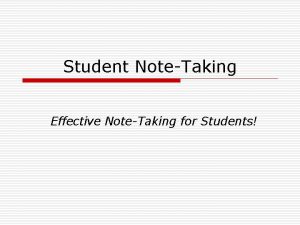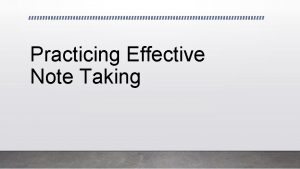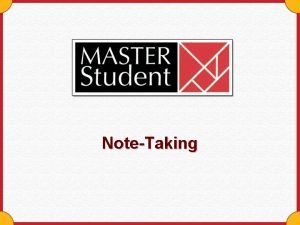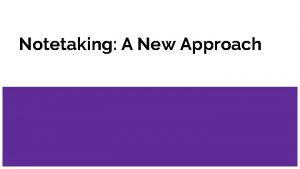Student NoteTaking Effective NoteTaking for Students Student NoteTaking










- Slides: 10

Student Note-Taking Effective Note-Taking for Students!

Student Note-Taking o Note-taking is one of the most important skills students can use to improve their understanding and retention of material they read and are taught in class. Yet it is also one of the most erratic and unmonitored student activities that occurs in the classroom. You can improve students' note-taking skills by explicitly teaching them how to do it effectively.

Give Students Teacher. Prepared Models o Give students a copy of teacher-prepared notes. Explain the method you used to prepare the notes (outline, webbed, etc. ) and allow them to follow along, adding their own notes during class. This gives students a model of how organized notes look and work. Explain that notes taken during class will probably not be quite as organized, but should follow the same general principles.

Teach Students Basic Note. Taking Principles o Students need direct instruction on what to include and what not to include in their notes. Many students try to write down every word the teacher says or try to busily copy an overhead while missing the most important aspects of a lecture or class discussion. Help students learn basic strategies for taking notes, such as coming to class prepared, listening for facts or main ideas, and using abbreviations.

Incorporate Note-Taking into Your Assessment Criteria o Ask students to re-write and re-organize their notes as homework. This allows students to review both the material and their note-taking skills. Ask students to hand them in for credit (no grade) and give written feedback to them, keeping in mind that note-taking is an art, not a science. Students will need to adapt basic notetaking skills to their own learning styles.

Student Tips for Note-Taking o o Come to class prepared - Always bring enough paper and a writing instrument of your choice to class. Start a new page for each new class. Also, put the date on the top of the first page. This way you will know where the notes for each class begin, which will help you keep the material organized. Consider keeping your notes organized in their own binder. Don’t try to write down every word your teacher says. You will not be able to, even if you can write very fast. More importantly, in trying to do so, you will miss the overall point your teacher is trying to make. Write down the big ideas. Listen for facts, connections, and main ideas. This may take a while to get used to, because you will need to divide your attention between listening to the teacher (or other students) and writing your notes. Don’t get frustrated. In time, this will become easier.

Student Tips for Note-Taking o o o Use abbreviations for commonly occurring names and words. You can develop your own abbreviations, so long as you don’t forget what they stand for. For example, in a lecture on Einstein, you might write his name out the first time, and then abbreviate it as ‘E’ throughout the rest of your notes. Long words such as government can become "gov’t" and federal can become "fed. " Develop your own system and stick to it, once it works. Leave lots of room on the page. When writing, leave ample space between ideas. This is like pausing before you begin a new sentence. Your notes will much easier to read, and you’ll have space to add information later on, if needed. Don’t try to cram everything onto one piece of paper.

Student Tips for Note-Taking o o o Write down corresponding page numbers from your textbook. Teachers often use the textbook to refer to ideas you’re learning in class. Recording the page number of corresponding ideas and homework assignments can come in handy later on. Review your notes for accuracy. It’s a good idea to look over your notes sometime after class for accuracy and completeness. Consider doing this just before doing your homework to get yourself back in the mindset of the material. Obtain notes for missed classes. Sometimes it’s necessary to miss class, but that shouldn’t stop you from getting notes for it. Consider forming a partnership with another student at the beginning of class on whom you can rely (and who can rely on you) for notes when a class is missed. Your teacher may also be willing to share his or her notes with you. The Mc. Graw-Hill Companies, Inc.

Note-Taking with The Writer

Note-Taking with The Writer is a great educational tool for in-class note-taking. Teachers are able to set up folders for students to work from. After the student has taken a class worth of notes, he/she can then take the information to a PC and send their work to Microsoft Word for further editing.
 Listening and notetaking skills
Listening and notetaking skills How to give effective feedback to your students brookhart
How to give effective feedback to your students brookhart How jose become the champion of filipino student?
How jose become the champion of filipino student? Guidelines for effective student assessment
Guidelines for effective student assessment Anatomi organ reproduksi
Anatomi organ reproduksi Smärtskolan kunskap för livet
Smärtskolan kunskap för livet Bris för vuxna
Bris för vuxna Argument för teckenspråk som minoritetsspråk
Argument för teckenspråk som minoritetsspråk Typiska novell drag
Typiska novell drag Trög för kemist
Trög för kemist Delegerande ledarstil
Delegerande ledarstil



















